11 Best CMS For NextJS In 2023

Are you searching for the best CMS for NextJS to pair with your next epic projects?
You’re not alone!
I’ve been there, too, digging through the vast ocean of content management systems, trying to find that one gem that syncs flawlessly with NextJS.
In this article, we’re diving deep into CMS options for NextJS. Whether you’re building a blog, an eCommerce site, or a full-fledged web application, I’ve got you covered.
From small to large apps, I included something for everyone.
I’ve spent hours researching, testing, and comparing to give you a comprehensive guide to the best available tools.
By the end of this article, you’ll have all the information you need to make the right decision to take your NextJS projects to the – well – next level!
This post covers:
The Best CMS For NextJS
Picking the suitable CMS for your NextJS project is more than just a checkbox on your to-do list.
It will make your development process smoother and empower your content team to shine without technical hurdles.
And hey, let’s remember the must-haves: seamless integrations, a user-friendly interface, and robust scalability to grow with your project.
It’s all about making your life easier and your website more powerful.
1. Strapi
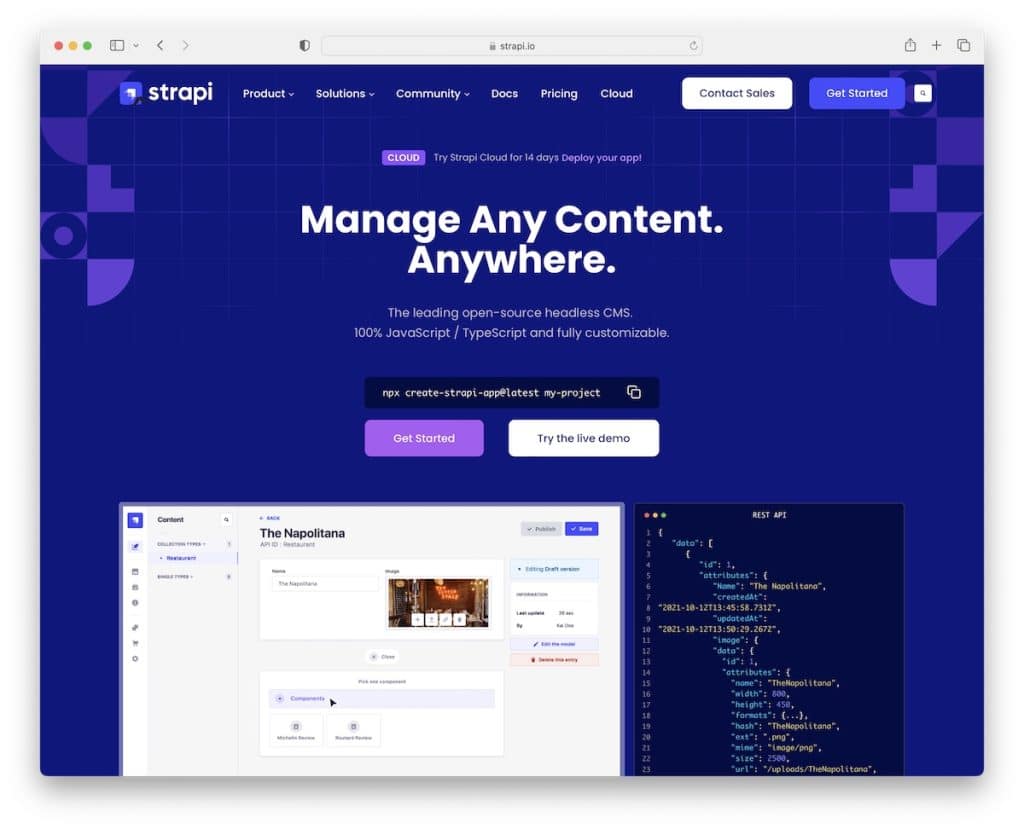
Strapi is the leading open-source headless CMS that’s taking the developer world by storm. It’s 100% JavaScript, fully customizable, and with a developer-first mindset.
Strapi’s intuitive interface means you spend less time figuring things out and more time creating amazing content types with ease.
And the best part? Customization is just a code editor away. Whether tweaking your API or reshaping data structures, Strapi allows you to create precisely what you need.
Flexibility is at the heart of Strapi. Its Content Type structure bends gracefully to fit your project needs, offering a plethora of fields and possibilities.
Moreover, it seamlessly integrates with any client, be it React (see best CMS for React), Vue, Angular, mobile apps, or even IoT, using REST or GraphQL. Plus, webhooks and auto-generated documentation make your development journey smoother than ever.
Strapi also ensures your content is dynamic and secure with robust authentication and permissions. And for the global audience, its internationalization capabilities let you create multilingual websites or apps with localized content.
Key Features of Strapi:
- It provides a back-end-only content management system, communicating with the NextJS front-end via RESTful or GraphQL APIs. (This allows for more flexibility and creative front-end designs.)
- Strapi offers extensive customization options. Developers can modify the API, data structures, and even the admin panel.
- Strapi supports various databases, including SQLite, MySQL, Postgres, and MariaDB.
- Auto-generated documentation makes it easier for developers to maintain and scale their applications over time.
- It supports webhooks for automatic triggers for various actions, useful for dynamic content updates in NextJS applications.
Best for:
Strapi is for developers and teams who require a flexible, customizable, and JavaScript-focused CMS that easily integrates with NextJS for dynamic, API-driven web projects.
Pricing: Strapi is a free and open-source CMS. But it also has various packages for enterprise projects and cloud solutions ($99/month+).
Get Strapi
2. DatoCMS
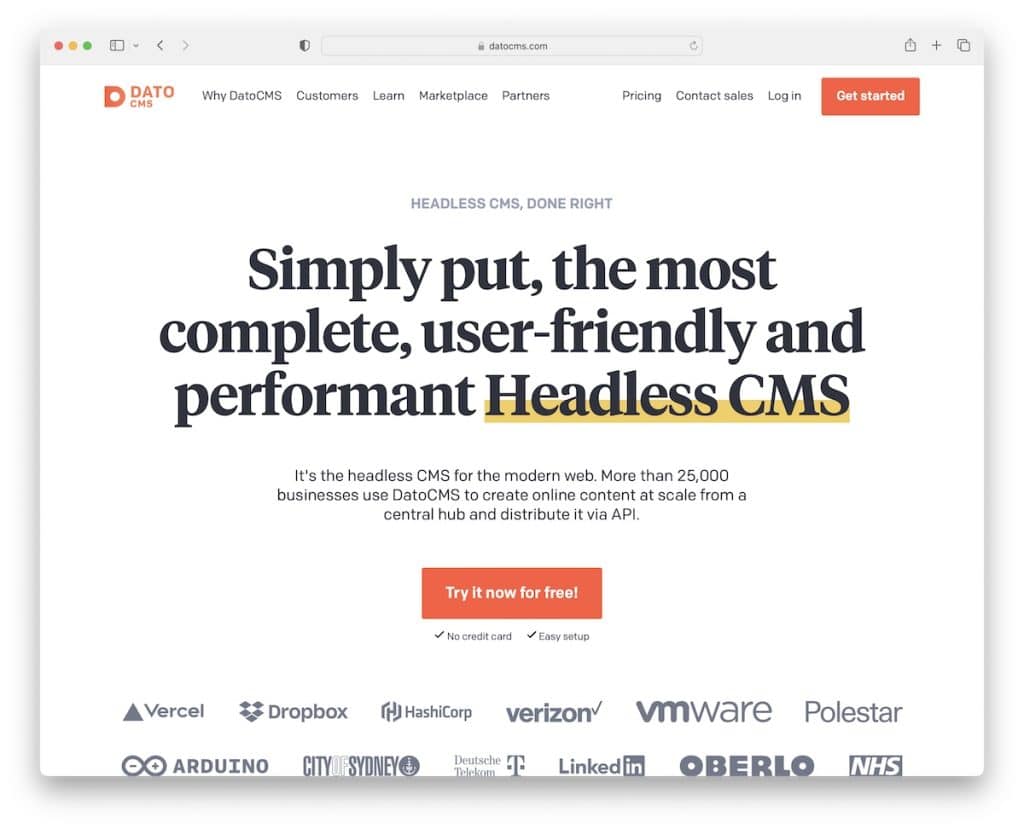
DatoCMS is a complete solution, a true technological investment for your entire team, empowering everyone involved in the content creation and distribution.
It boosts your workflow like never before. From idea to market, you’re looking at hours, not months.
This headless CMS ensures you have your content in one place, managing it effortlessly and pushing updates instantly across all digital platforms.
It’s about keeping everyone in sync and your content future-proof, delivering real omnichannel experiences.
DatoCMS’s flexible content model allows fast iterations and instant prototyping, offering a repeatable architecture for all your projects.
And when it comes to speed, DatoCMS is unmatched. With a global delivery network spanning over 200 cities in 90+ countries, your content is secure, performant, and right where your audience is. This reduces architectural complexities, ensures scalability, and offers seamless integrations with any digital product.
DatoCMS perfectly aligns with the agility and scalability of NextJS.
Key Features of DatoCMS:
- A single hub for managing all your content, ensuring consistency and ease of access across various digital platforms.
- The platform supports instant content updates so real-time changes are immediately reflected on your NextJS site.
- DatoCMS is designed to deliver content across multiple channels, ensuring a seamless omnichannel experience.
- You can accelerate your content-to-market process, benefiting from fast iterations and instant prototyping capabilities.
- It is designed with scalability in mind, handling increased demands effortlessly and adapting to the growing needs of your NextJS project. (It also includes a robust CDN.)
Best for:
DatoCMS is for teams and developers seeking a user-friendly, scalable, and efficient headless CMS that integrates with NextJS to manage and deliver content across multiple channels.
Pricing: You can test DatoCMS free of charge. But you can also pick any pro plans, starting at $162/month for Professional.
Get DatoCMS
3. Ghost
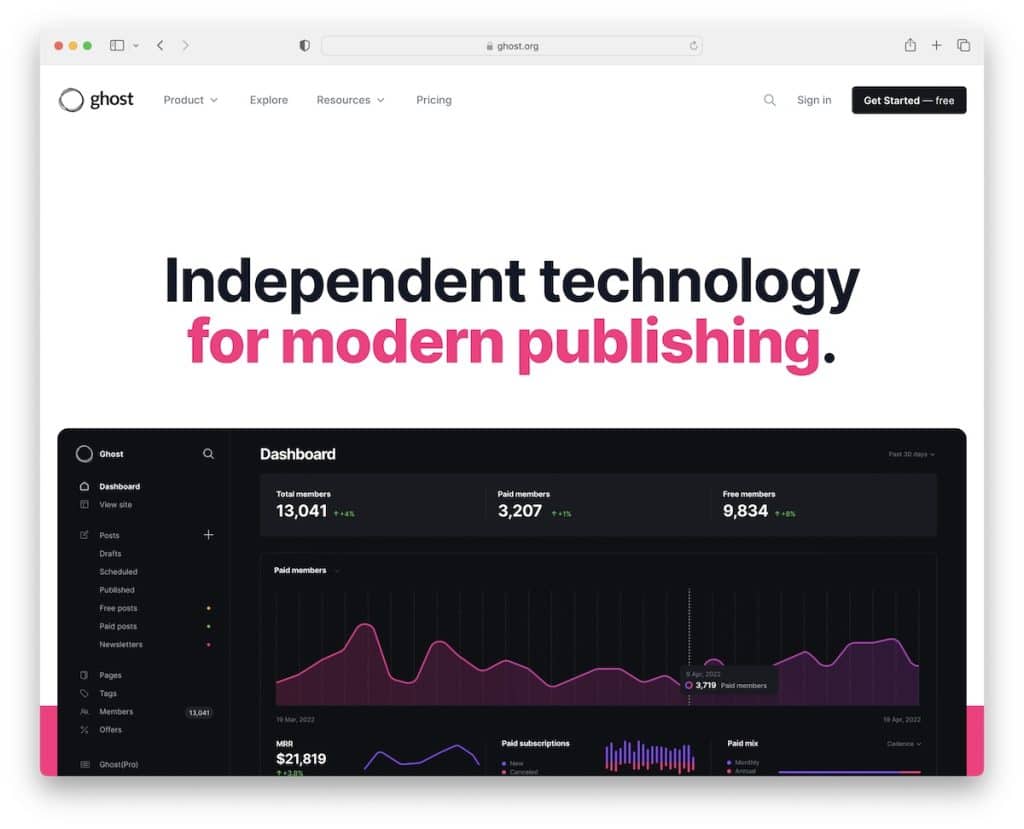
Ghost feels like discovering a hidden gem in the CMS world, especially for NextJS projects. It’s all about simplicity and efficiency, which is why I enjoy it so much.
Ghost is incredibly sleek and user-friendly, so you focus on what matters most – your content. You don’t need to be a tech wizard to master it.
Plus, it’s built on JavaScript, making it a natural fit for NextJS, like peanut butter and jelly.
But Ghost isn’t just about good looks and easy navigation. It’s a powerhouse for SEO to enjoy better (and higher) ranks and shine bright in the digital universe.
And let’s talk about speed. Ghost is lightning fast, ensuring your content loads swiftly and offering a seamless experience to your audience.
What’s also cool about Ghost are the robust membership and subscription features. This makes it a fantastic choice for building a community or a subscription-based service.
Dive into Ghost and watch your content strategy soar.
Key Features of Ghost:
- Ghost is designed with SEO in mind. It automatically handles SEO essentials like meta tags, permalinks, and sitemaps for better search visibility.
- Known for its speed, Ghost ensures quick loading times for your website. This performance aligns well with NextJS’s fast rendering capabilities.
- Ghost provides a clean, intuitive content management interface for content creators and developers to work efficiently without a steep learning curve.
- Built-in membership and subscription management tools for creating subscription-based content platforms directly integrated with your NextJS project.
Best for:
Ghost is for bloggers, content creators, and developers who prioritize SEO, performance, and ease of use, and are looking for a sleek, JavaScript-based CMS to complement their NextJS projects.
Pricing: Ghost is free and open-source. Or you can opt for the paid managed solution, with the entry-level plan going for $9/month.
Get Ghost
4. Contentful
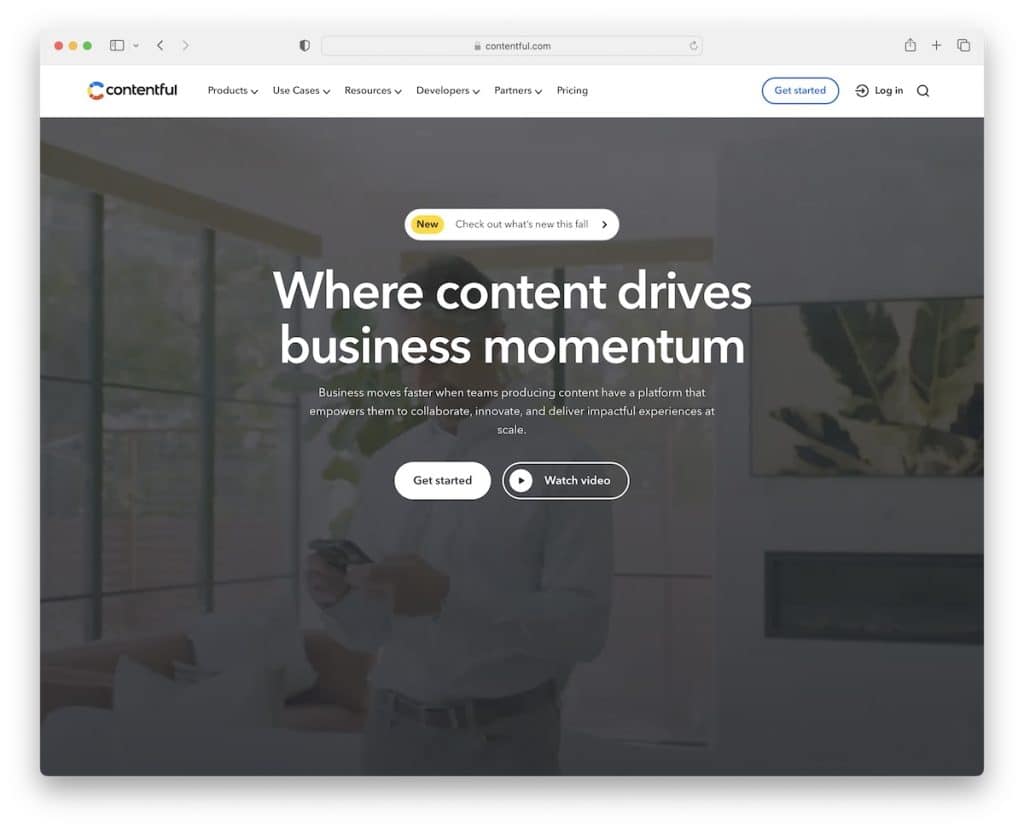
Contentful is where simplicity meets sophistication. It allows you to arrange and manage content for different brands, use cases, or regions, making it reusable and adaptable.
Besides organization, it’s also about delivering top-notch experiences across any channel. Streamlining your publishing process to provide personalized, high-quality content and elevating your NextJS project to a realm of vivid and engaging user experiences is very doable.
With features like Visual Modeler and AI Content Type Generator, you can plan, build, and iterate your content models visually and intelligently.
And for the data-conscious, Contentful’s EU data residency offering ensures compliance and security, a crucial aspect in today’s digital landscape. (Elevated governance with robust security frameworks protects your content and peace of mind.)
Contentful is the ultimate blend of efficiency, innovation, and security to empower every team member.
Key Features of Contentful:
- Centralize all your content, like images, text, and articles, in one place, forming an integrated content graph for easy access and management.
- Contentful streamlines publishing to deliver high-quality, personalized experiences across various channels.
- Visual Modeler for planning and building content models and an AI Content Type Generator that assists in designing and building content structure.
Best for:
Contentful is for developers, marketers, and content editors who need a flexible, scalable, and omnichannel-friendly CMS to integrate with NextJS for diverse, large-scale digital projects.
Pricing: You have the freedom to start for free with Contentful. But there are also two paid plans, Basic ($300/month) and Premium (custom pricing).
Get Contentful
5. Storyblok
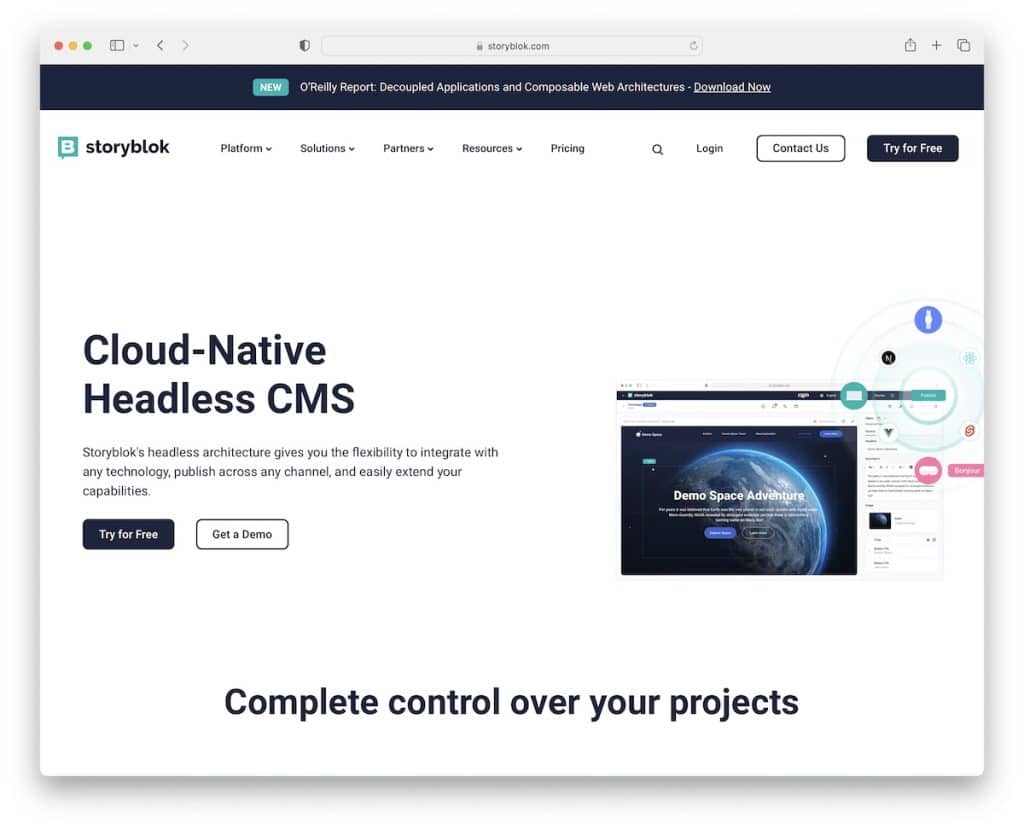
Storyblok brings to the table a headless architecture that allows you to work with any technology and publish across multiple channels.
Its powerful APIs and integrations, including GraphQL, REST, and Management APIs, make it a developer’s delight. These features ensure that Storyblok melds seamlessly with your tech stack through native integrations or comprehensive frontend SDKs.
Completely customizable and extendable, Storyblok empowers you to create bespoke content experiences. Craft custom apps, plugins, and field types that align perfectly with your NextJS project.
The Visual Editor in Storyblok enhances your workflow with intuitive, real-time editing and collaboration features. Moreover, the Component Composer and Global Components ensure consistent branding and technical SEO optimization at every turn.
In short, Storyblok equips you with everything you need to create and scale standout content experiences for your NextJS projects.
Key Features of Storyblok:
- Storyblok makes it easy for developers to integrate with various technologies and platforms, thanks to GraphQL API, REST API, and Management APIs.
- Highly customizable and extendable content structures to create custom apps, plugins, and field types for specific needs.
- As a cloud-native CMS, Storyblok ensures high security and performance standards, including ISO 27001 certification, autoscaling, and global CDN support.
- Integrated discussions and workflows within the Visual Editor allow component-level comments and efficient teamwork.
Best for:
Storyblok is for developers and content teams seeking a flexible, intuitive, and scalable headless CMS for creating dynamic, multi-channel digital NextJS experiences.
Pricing: Build your project for free with Storyblok, or go with the Entry plan for $108/month.
Get Storyblok
6. Sanity
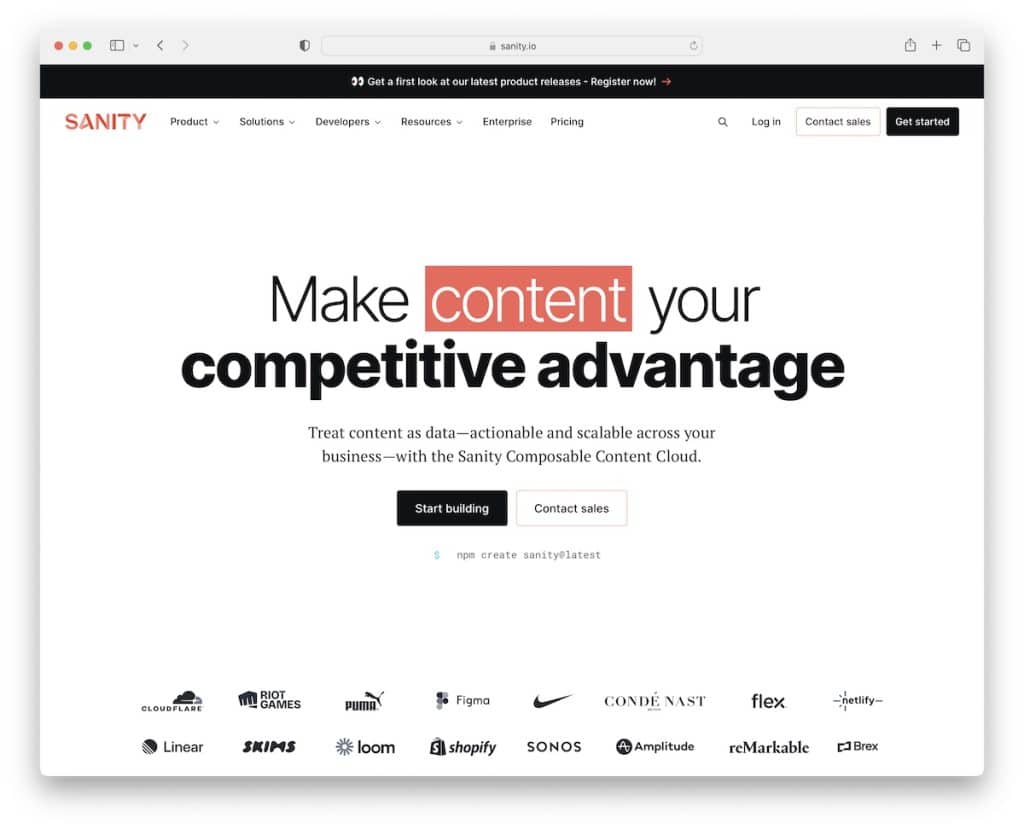
Sanity’s deeply customizable content workspaces, complete with real-time collaboration and intelligent image handling, are a dream come true for content teams.
It syncs beautifully with your NextJS app, ensuring a seamless, dynamic user experience.
On the tech side, Sanity’s APIs are the fabric of your composable content architecture. They allow precise content queries and are interoperable across your entire tech stack, collaborating effortlessly with emerging technologies.
Sanity’s Content Lake is the heart of your content operation, offering cloud-hosted, fully managed storage, intelligent caching, and robust interfaces. It’s where your content breathes and thrives.
Sanity covers everything from limitless landing page compositions to data-driven customer experience optimization, personalized buyer journeys, and efficient content management for support channels.
Key Features of Sanity:
- Sanity Studio provides a highly customizable content workspace that you can tailor to mirror your business needs.
- The platform offers real-time collaboration capabilities so multiple users can simultaneously work on the same document.
- With its cloud-hosted, fully managed infrastructure, Sanity ensures robust content delivery with intelligent caching and a global CDN.
- Cater to various industries and needs, including marketing, eCommerce, media, and support.
Best for:
Sanity is for developers, content creators, and teams across various industries who seek a highly customizable, scalable, and collaborative content management system to enhance their NextJS-based projects.
Pricing: Individuals can start working with Sanity for free. But you can also jump right to the Growth plan for $15/month.
Get Sanity
7. Suncel
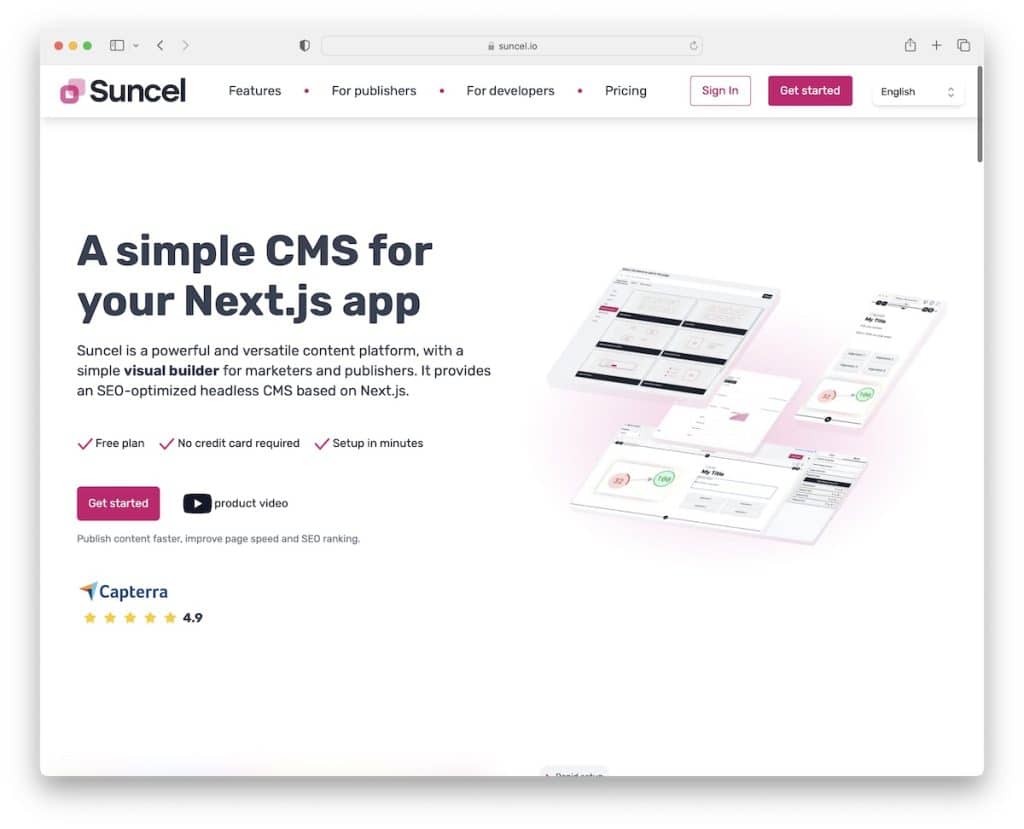
Suncel is more than just a CMS; it’s a creative hub specially crafted to supercharge your NextJS experience.
It offers high-precision drag-and-drop editing to use components with smart, quick access multiple times. And guess what? It’s multi-language capable, ensuring you reach a global audience without breaking a sweat.
Thanks to its ability to access previous versions, you’ll never lose a change again. Plus, you can assign specific publishing access to users and effortlessly generate sitemaps for new and updated pages.
For the developers out there, Suncel ensures super easy integration with Next.js to create a reusable components library, customizing to your heart’s content.
Suncel combines a user-friendly design with developer-oriented flexibility, making it the perfect companion for your NextJS journey.
Key Features of Suncel:
- Drag-and-drop visual editor, enabling high precision and ease in designing layouts.
- Using one component multiple times within the editor enhances efficiency and consistency across your NextJS project.
- Automatic sitemap generation for new pages and updates enhances SEO and ensures that search engines can easily navigate and index your site.
- Access to previous versions of your content ensures that no changes are ever lost, providing a safety net for content editors.
Best for:
Suncel is for developers and content creators who value precision, efficiency, and multi-language support, and seek a user-friendly yet powerful CMS with customizable components and innovative workflow features.
Pricing: Build small projects with Suncel free of charge. Once you are ready to upgrade, kick it off with the Start plan for $29/month.
Get Suncel
8. Prismic
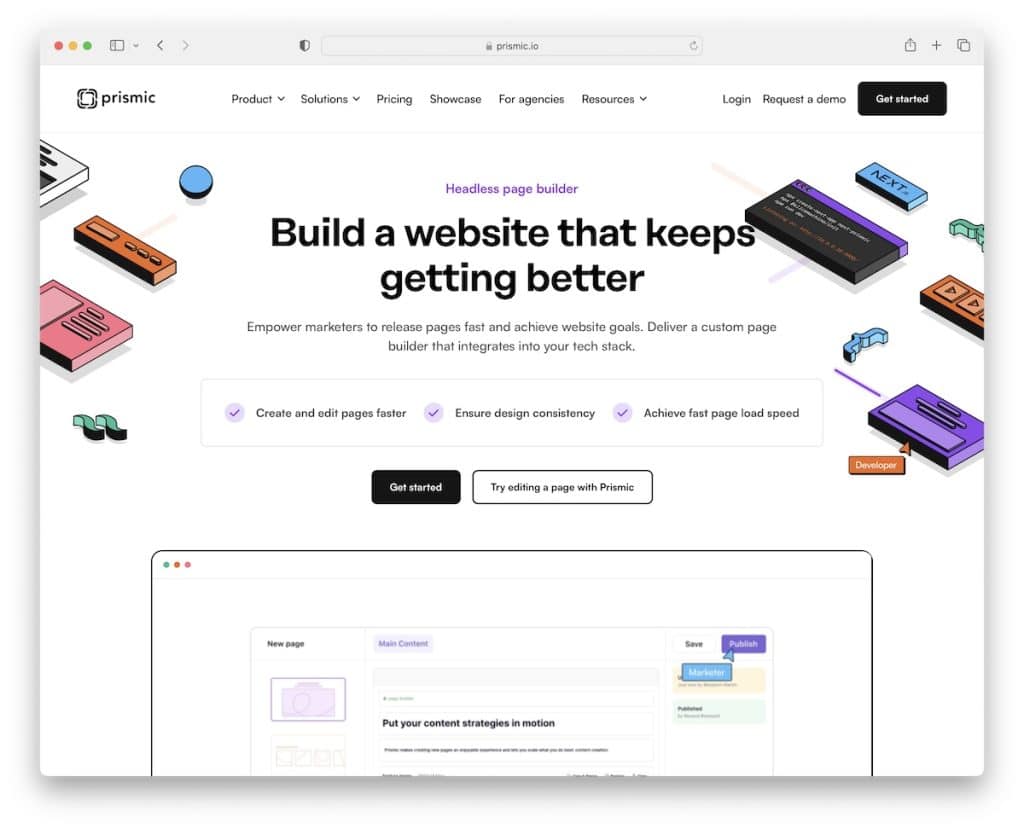
Prismic is a creative playground that meshes with NextJS, bringing a whole new level of excitement to your web projects.
It shines with its Slices feature – think of them as building blocks for your website but for content.
They’re like legos you can piece together to create unique, engaging layouts, making your content informative and visually striking.
Then there’s the Slice Machine, Prismic’s local development tool. It’s where the magic of configuring Prismic becomes a reality.
Slice Machine bridges the gap between developers and content creators, ensuring that your design perfectly aligns with what appears on your site.
And the Prismic Editor? It’s where your content comes to life. This user-friendly app allows writers to unleash their creativity, piecing together stories with ease and precision.
Key Features of Prismic:
- Slices act like customizable building blocks for web content, similar to website components but specifically for content.
- Slice Machine is a local development tool that lets developers configure Prismic more efficiently.
- Content editor is user-friendly and intuitive, allowing creators to craft and manage content efficiently.
- Robust content versioning and scheduling for better control over content publication and revisions.
Best for:
Prismic is for developers and content creators seeking a modular, intuitive, and API-driven CMS to integrate and manage dynamic, multi-language content for their NextJS projects effortlessly.
Pricing: Prismic allows you to build personal websites or a PoC for free. But unlock more options and possibilities with its pro packages, starting at $100/month.
Get Prismic
9. Enonic
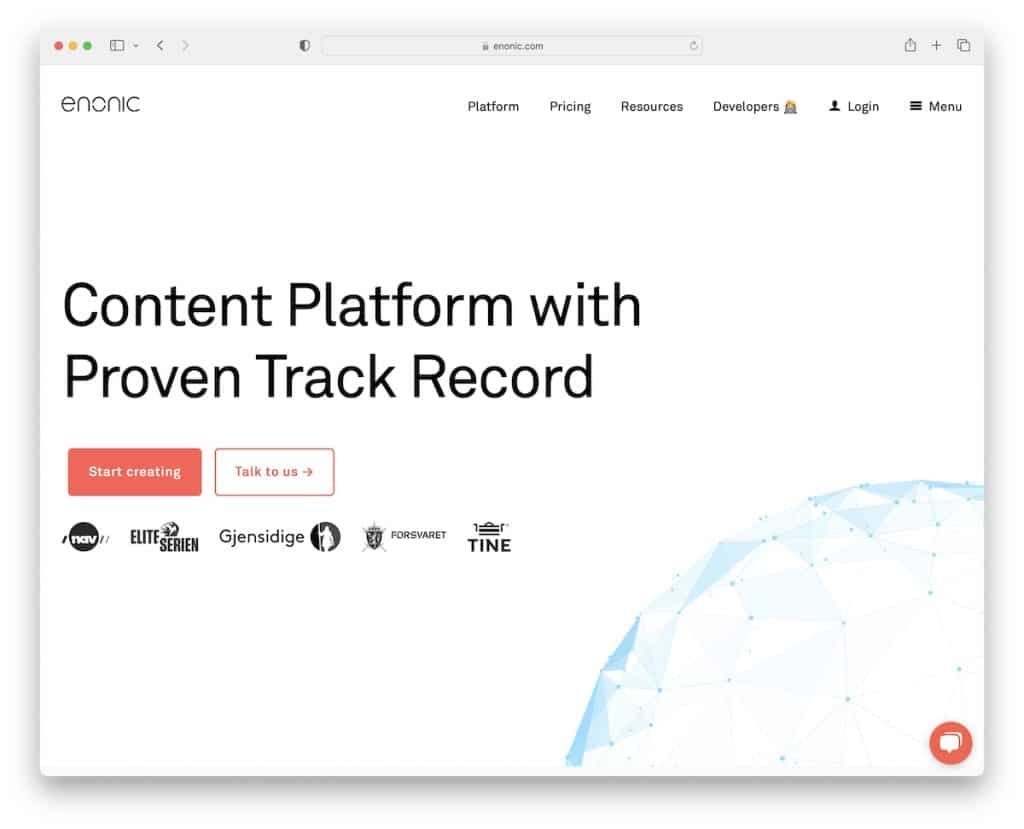
Enonic is a day-to-day partner to make your work life smooth and enjoyable.
It complements your NextJS projects with a straightforward and intuitive workflow. Creating, editing, and publishing content only takes a few heartbeats, with instant content validation.
Collaboration is a breeze in Enonic. It’s tailor-made for editorial teams with features for creating and assigning issues, commenting, and email notifications.
And smart image handling? Epic! The focal point feature ensures your images look perfect, no matter the cropping.
Localization is another star feature. Adapt your content to different markets with unique layers functionality, inheritance model, and individual access control.
The visual page editor is where creativity meets functionality. Drag and drop custom components, rearrange them, and customize your content to the finest detail.
Why Enonic for NextJS? Because it combines efficiency, collaboration, and innovation in a user-friendly package.
Key Features of Enonic:
- A streamlined workflow for content creation, editing, and publishing. It also includes review and approval processes.
- Enonic provides interactive and responsive previews, including a device emulator, allowing editors to see how content will look on various devices.
- The inheritance model manages different content layers and access control and is ideal for tailoring content to diverse markets (read: localization).
- Easy separation of different sites and content collections into distinct projects.
Best for:
Enonic is for teams and developers working with NextJS who need a flexible, collaborative, and intuitive CMS with advanced image handling, localization, and multi-project management capabilities.
Pricing: Developers can start working with Enonic for free. But for production deployments, it goes for $990/month.
Get Enonic
10. Agility
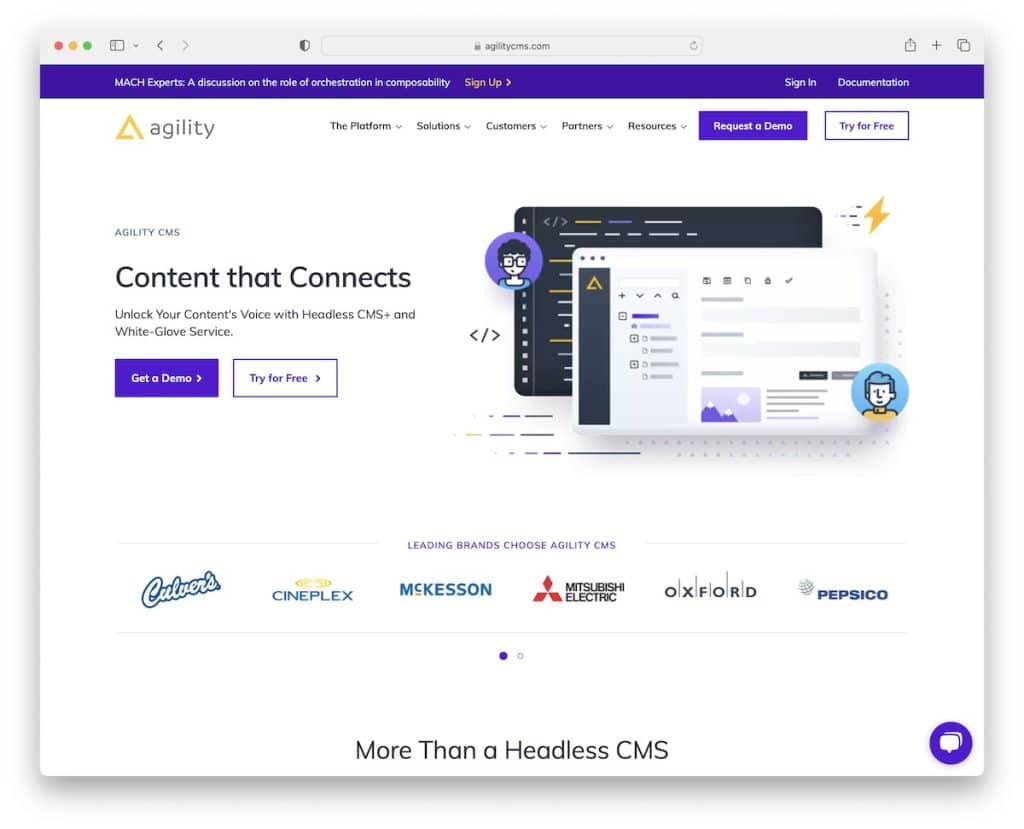
Agility shines with its marketing features, giving you complete control over how your content appears on every device.
It’s packed with user-friendly authoring tools and content preview options, so content structuring and management across all channels is a breeze.
From page and module management to multi-site support and SEO optimization, Agility covers all bases to ensure your content perfectly aligns with your digital strategy.
Content sharing, scheduling, and workflow management are effortless, supported by analytics, unlimited version history, and digital asset management. Plus, its multilingual capabilities and custom roles make it a global player in content management.
Its API-first approach lets developers build incredible digital experiences using any programming language or front-end framework.
The flexibility is limitless – custom content fields, omnichannel delivery, and integrations with leading tools mean you can bring your creative visions to life with Agility.
Agility combines powerful marketing and developer tools focusing on performance, scalability, and ease of use.
Key Features of Agility:
- Robust content management tools include page, module, sitemap management, multi-site support, URL routing management, SEO fields, and content and page previewing.
- It is flexible and extensible to support any programming language, custom content fields, omnichannel delivery, Restful API, multiple front-end integrations, content sync SDK, and WebHooks.
- The content delivery network (CDN) ensures fast and reliable access to APIs and digital assets.
Best for:
Agility is for developers and marketers in fast-paced, growth-oriented organizations who need a robust, scalable, and flexible CMS to deploy and manage diverse, multi-channel NextJS projects rapidly.
Pricing: While you can try Agility for free, the real fun becomes with any of the elite plans, starting at $1,249/month.
Get Agility
11. Hygraph
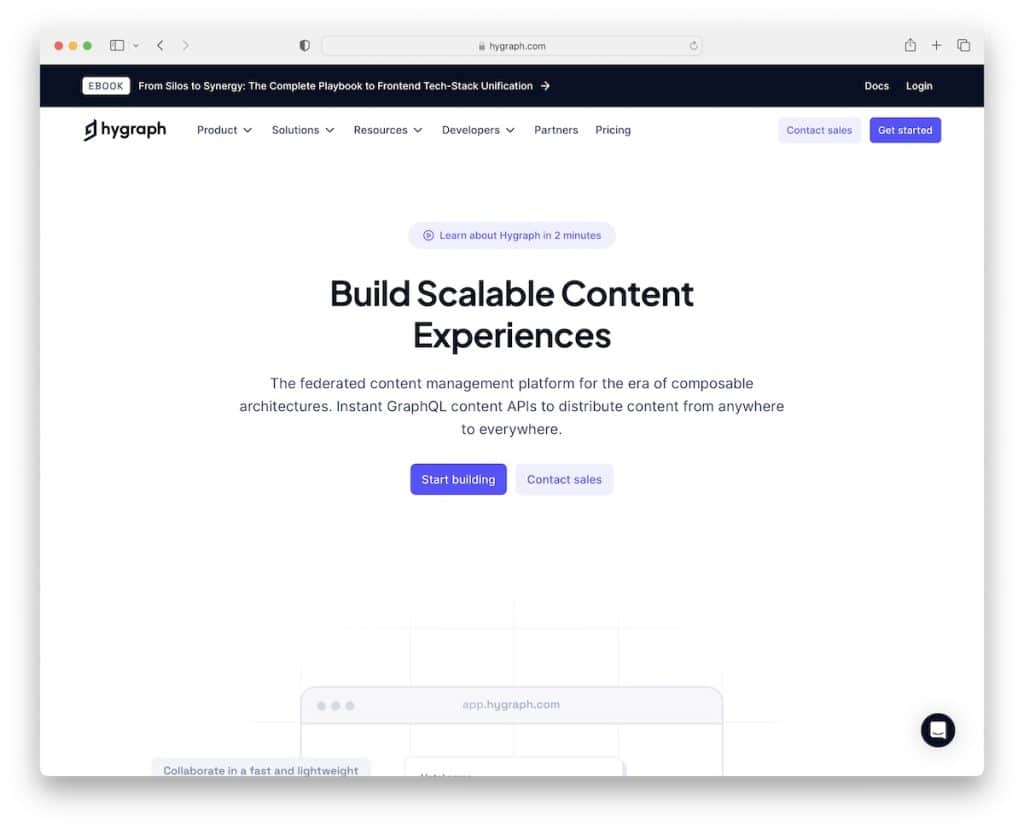
With Hygraph, enjoy crafting content models, reusable components, and references through the user-friendly UI or programmatically with the SDK.
Editing with Hygraph is a dream for content teams. It enables efficient content creation and collaboration on a grand scale with advanced tools at your fingertips.
Hygraph lets you source and enrich content from other systems, seamlessly unifying multiple APIs into one GraphQL endpoint. Also, define team roles with fine-grained permissions, custom workflows, and content stages.
Furthermore, it can easily manage and publish content in different languages, all from one central location.
And when it comes to building, Hygraph empowers engineering teams to develop omnichannel digital experiences rapidly for quicker iterations and launches.
Need to extend? As your project scales, Hygraph’s scalable infrastructure ensures your applications are fast and can handle large traffic volumes.
Hygraph is the perfect blend of structure, editability, management, localization, and security, all wrapped up in a developer-friendly package.
Key Features of Hygraph:
- Teams can efficiently create, edit, and collaborate on content at a large scale with advanced editing features and tools for maximum productivity.
- The platform can enrich existing content with information from other systems and unify multiple APIs into a single GraphQL endpoint.
- It ensures security, compliance with SOC 2 Type 2 and GDPR standards, and hosting on ISO 27001 certified infrastructure.
Best for:
Hygraph is for developers and content teams who require a scalable, flexible, and omnichannel content management system with advanced editing and localization capabilities for their complex NextJS projects.
Pricing: Hygraph has a free forever plan for personal and small-scale projects. But for serious work, the Self Service solution at $299/month+ will do the trick.
Get Hygraph
What Is The Best CMS For NextJS
You have plenty of CMS options to choose from for your amazing NextJS projects, but these are our favorites:
- Strapi is a headless CMS that pairs seamlessly with Next.js. It offers developers complete control over their content API and the freedom to design their front-end without constraints, making it a top choice for projects requiring extensive customization and scalability.
- DatoCMS is known for its ease of integration with Next.js, providing a streamlined, user-friendly content management interface and GraphQL-based API for efficient content delivery and excellent developer experience in Next.js environments.
- Ghost stands out with its focus on simplicity and speed, offering a lightweight, content-focused CMS solution that integrates smoothly with Next.js, making it ideal for bloggers and publishers who prioritize fast, SEO-friendly content delivery and minimalistic design.
How To Get Started With Strapi
Frequently Asked Questions (FAQs)
What makes a CMS compatible with NextJS?
A CMS is compatible with NextJS if it offers a headless architecture, API support (REST or GraphQL), and flexibility in content modeling.
Is there a performance advantage to using a headless CMS with NextJS?
Yes, headless CMSs can improve performance by separating the content management from the presentation layer, allowing for faster content delivery and better scalability.
Can I use a traditional CMS like Joomla with NextJS?
While possible, using a traditional CMS like Joomla with NextJS requires additional configuration and might not offer the same level of flexibility as a headless CMS.
What security considerations should I have when using a CMS with NextJS?
Ensure the CMS has robust authentication and authorization features, regular security updates, and consider implementing additional security measures like API rate limiting.
How important is the CMS’s API performance for a NextJS site?
The CMS’s API performance is crucial as it directly affects the loading time and overall performance of the NextJS site, especially for dynamic content.
Can I use a CMS for managing static pages in NextJS?
Absolutely! A CMS can manage static pages in NextJS by providing the content for static site generation (SSG), which is then built at deployment time for optimized performance and SEO.
How does a CMS impact the scalability of a NextJS application?
The CMS choice can significantly impact scalability. A CMS that offers robust APIs, efficient content delivery, and handles high traffic well will support the scaling of a NextJS application.
Is it possible to switch CMS platforms later in a NextJS project?
Yes, it’s possible, but it can be complex. It involves migrating content and adjusting the NextJS application to interact with the new CMS’s APIs. Planning and testing are crucial for a smooth transition.
How do I handle media assets in a NextJS project using a CMS?
Most CMS platforms offer media asset management. In a NextJS project, you would fetch these assets via the CMS’s API and integrate them into your pages or components, often with options for optimization and transformation.
What are the advantages of using a headless CMS over a traditional CMS with NextJS?
Headless CMSs offer more flexibility, better performance, and are more suited for modern web architectures like NextJS. They provide content through APIs, allowing for more dynamic and rich user experiences than traditional CMSs, often limited by their front-end design constraints.
Does the choice of CMS affect the SEO of a NextJS website?
Yes, the choice of CMS can impact SEO. A CMS that allows easy management of SEO elements like meta tags, structured data, and URLs, and supports efficient content delivery (important for page load speed) can positively influence the SEO of a NextJS website.
Was this article helpful?
YesNo


